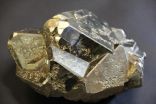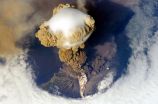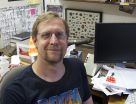(Press-News.org) MADISON, Wis. - As the installation of photovoltaic solar cells continues to accelerate, scientists are looking for inexpensive materials beyond the traditional silicon that can efficiently convert sunlight into electricity.
Theoretically, iron pyrite -- a cheap compound that makes a common mineral known as fool's gold -- could do the job, but when it works at all, the conversion efficiency remains frustratingly low. Now, a University of Wisconsin-Madison research team explains why that is, in a discovery that suggests how improvements in this promising material could lead to inexpensive yet efficient solar cells.
"We think we now understand why pyrite hasn't worked," says chemistry Professor Song Jin, "and that provides the hope, based on our understanding, for figuring out how to make it work. This could be even more difficult, but exciting and rewarding."
Although most commercial photovoltaic cells nowadays are based on silicon, the light-collecting film must be relatively thick and pure, which makes the production process costly and energy-intensive, says Jin.
A film of iron pyrite -- a compound built of iron and sulfur atoms -- could be 1,000 times thinner than silicon and still efficiently absorb sunlight.
Like silicon, iron and sulfur are common elements in the Earth's crust, so solar cells made of iron pyrite could have a significant material cost advantage in large scale deployment. In fact, previous research that balanced factors like theoretical efficiency, materials availability, and extraction cost put iron pyrite at the top of the list of candidates for low-cost and large-scale photovoltaic materials.
In the current online edition of the Journal of the American Chemical Society, Jin and first author Miguel Cabán-Acevedo, a chemistry Ph.D. student, together with other scientists at UW-Madison, explain how they identified defects in the body of the iron pyrite material as the source of inefficiency. The research was supported by the U.S. Department of Energy.
In a photovoltaic material, absorption of sunlight creates oppositely charged carriers, called electrons and holes, that must be separated in order for sunlight to be converted to electricity. The efficiency of a photovoltaic solar cell can be judged by three parameters, Jin says, and the solar cells made of pyrite were almost totally deficient in one: voltage. Without a voltage, a cell cannot produce any power, he points out. Yet based on its essential parameters, iron pyrite should be a reasonably good solar material. "We wanted to know, why is the photovoltage so low," Jin says.
"We did a lot of different measurements and studies to look comprehensively at the problem," says Cabán-Acevedo, "and we think we have fully and definitively shown why pyrite, as a solar material, has not been efficient."
In exploring why pyrite was practically unable to make photovoltaic electricity, many researchers have looked at the surface of the crystals, but Cabán-Acevedo and Jin also looked inside. "If you think of this as a body, many have focused on the skin, but we also looked at the heart," says Cabán-Acevedo, "and we think the major problems lie inside, although there are also problems on the skin."
The internal problems, called "bulk defects," occur when a sulfur atom is missing from its expected place in the crystal structure. These defects are intrinsic to the material properties of iron pyrite and are present even in ultra-pure crystals. Their presence in large numbers eventually leads to the lack of photovoltage for solar cells based on iron pyrite crystals.
Science advances by comprehending causes, Jin says. "Our message is that now we understand why pyrite does not work. If you don't understand something, you must try to solve it by trial and error. Once you understand it, you can use rational design to overcome the obstacle. You don't have to stumble around in the dark."
INFORMATION:
CONTACT: Song Jin, 608-262-1562, jin@chem.wisc.edu (prefers email for first contact)
--David Tenenbaum, 608-265-8549, djtenenb@wisc.edu
The most emergent form of heart attacks is decreasing nationwide, but this declining incidence could affect emergency departments' quality and timeliness of care.
This is the key finding of a Vanderbilt University study released today in the American Journal of Cardiology and presented at the national American Heart Association meeting in Chicago this week.
Using data from the Nationwide Emergency Department Sample, the nation's largest database of information about emergency department visits, the researchers found that approximately 250,000 patients present in emergency ...
Philadelphia, PA, November 18, 2014 - Care gaps are emerging due to disharmony between healthcare reimbursement policies and evidence-based clinical guideline recommendations, cautions a group of Canadian physicians. Writing in the Canadian Journal of Cardiology, they use the example of stroke prevention in atrial fibrillation (AF) to make a case for engaging with policy-makers to address the growing barriers to patients' access to optimal care.
Stroke is a costly disease, imposing a significant human, societal, and economic burden. AF affects about one in eight people ...
Computerized cognitive training (CCT) has been widely promoted for older adults, but its effectiveness for cognitively health older adults has been unclear in systematic reviews to date. In a new systematic review and meta-analysis published in this week's issue of PLOS Medicine, Michael Valenzuela (Brain and Mind Research Institute, University of Sydney, Sydney, New South Wales, Australia) and colleagues evaluated 52 datasets in 51 studies and found a small overall effect of CCT (g = 0.22; 95% CI 0.15 to 0.29, where g END ...
Computer based 'brain training' can boost memory and thinking skills in older adults, but many programs promoted by the $1 billion brain training industry are ineffective, reveals new research by the University of Sydney.
Published today in PLOS Medicine, the study shows that engaging older adults computer-based cognitive training (also known as brain training) can lead to improvements in memory, speed, and visuospatial skills.
However, it has no impact on attention or executive functions such as impulse control, planning and problem solving.
Brain degeneration ...
HOUSTON, Nov. 18, 2014 - The quest of University of Houston professor Richard Meisel to understand how and why males and females differ may one day lead to a more effective means of pest control - namely, the pesky house fly.
Meisel, an assistant professor in the UH Department of Biology and Biochemistry, collaborated with several scientists on sequencing the house fly genome. The results were recently published in the open-access journal Genome Biology.
"The house fly genome will be a useful resource for understanding how pest species are able to exist in their environment ...
WASHINGTON, DC-- Small volcanic eruptions might eject more of an atmosphere-cooling gas into Earth's upper atmosphere than previously thought, potentially contributing to the recent slowdown in global warming, according to a new study.
Scientists have long known that volcanoes can cool the atmosphere, mainly by means of sulfur dioxide gas that eruptions expel. Droplets of sulfuric acid that form when the gas combines with oxygen in the upper atmosphere can remain for many months, reflecting sunlight away from Earth and lowering temperatures. However, previous research ...
EUGENE, Ore. -- Nov. 18, 2014 -- Leave it to long-dead short-tailed shrew and flying squirrels to outfox climate-modelers trying to predict future habitats.
Evidence from the fossil record shows that gluttonous insect-eating shrew didn't live where a species distribution technique drawn by biologists put it 20,000 years ago to survive the reach of glaciers, says University of Oregon geologist Edward B. Davis. The shrew is not alone.
According to a new study by Davis and colleagues, fossil records of five ancient mammalian species that survived North America's last glacial ...
Hamilton, ON (Nov. 18, 2014) - McMaster University researchers have found new evidence that suggests patients with a history of adverse reaction to the blood thinner heparin may be ready for urgent heart surgery sooner with a combination of appropriate blood screenings and therapeutic plasma exchange.
The study was published online today in Blood, the journal of the American Society of Hematology. The lead author is Dr. Theodore Warkentin, a professor in the Department of Medicine's Division of Hematology and Thromboembolism and the Department of Pathology and Molecular ...
The consumption of a diet high in fructose throughout adolescence can worsen depressive- and anxiety-like behavior and alter how the brain responds to stress, according to new animal research scheduled for presentation at Neuroscience 2014, the annual meeting of the Society for Neuroscience and the world's largest source of emerging news about brain science and health.
"Our results offer new insights into the ways in which diet can alter brain health and may lead to important implications for adolescent nutrition and development," said lead author Constance Harrell of ...
Washington, D.C. - November 18, 2014 - Lumosity is presenting new research today at the 2014 Society for Neuroscience conference on how altering cognitive task parameters affects learning rates. The study, titled "Optimizing Cognitive Task Designs to Improve Learning Rates in a Large Online Population," analyzed game play performance from 99,022 participants, and found that participants operating closer to their performance threshold earlier in their experience with a cognitive task tend to have faster learning rates - especially at higher levels of difficulty.
"By looking ...



